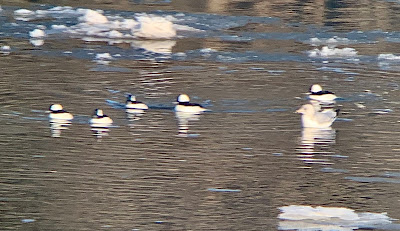In late December we had a cold snap in New York. During and after it a number of uncommon (for Inwood Hill Park) waterbirds were spotted in the park. On December 23 Allen and Karina Greene found an American Coot. On December 26 I spotted three scaup from my window which Danny Karlson saw from in the park and identified as Lesser Scaup; the same day Allen and Karina photographed a female Northern Pintail. On December 31 Hilary Russ spotted a Red-throated Loon in the main channel and Danny found an American Wigeon. All these species have occurred before in Inwood, but they are all uncommon.
When I checked my records I found that the last time I saw American Wigeon, Lesser Scaup, and American Coot had all been in the winter of 2014. In fact, the winter of 2014 produced quite a variety of waterbirds in Inwood Hill Park. January 2014 saw a shift south in the Polar Vortex with record low temperatures throughout the eastern United States. New York City recorded temperatures in the low single digits in early January. The following observations are mostly from my observations in Inwood Hill Park from January to April 2014 — American Wigeon, March 10 (3 birds); Ring-necked Duck, March 13 (3); Canvasback, February 2 to March 18 (up to 13 birds); Redhead, February 23 (1 male); Greater and Lesser scaups (plus unidentified scaups), January 27 to March 18 (usually 1 to 3 birds); Common Goldeneye, mid-March, female (seen by James Knox and Nadir Souirgi); Bufflehead, March 16 to 18 (1 - 2 birds); White-winged Scoter, March 6 to April 5 (up to 5 birds); Red-breasted Merganser, February 12 to April 12 (up to 7 birds); non-waterfowl: American Coot, January 6 (1) and probably the rarest waterbird I saw in Inwood that winter a Red-necked Grebe on April 6. The grebe was part of a large influx of the species into the New York City/Long Island area that winter with one also occurring on the reservoir in Central Park. Most of these sightings are recorded in blog entries I made on this blog in that time period. Almost undoubtedly related to the weather pattern that produced this variety of birds locally was the stunning occurrence of a Willow Ptarmigan that showed up at Three Mile Bay in Jefferson County near the Canadian border in far northern New York State that I went up to see on April 27 with Doug Gochfeld and Sean Sime. The ptarmigan was eventually found dead and the specimen ended up in the American Museum of Natural History.)
It is still too early in the winter to know what sort of weather we will have this year, but we have already had one cold snap in December. Another stretch of cold weather is predicted for this coming week with several days in a row with highs for the day below freezing. This is also going to produce even colder temperatures inland and will undoubtedly freeze many interior water bodies. Therefore, this coming week and beyond should be a good time to watch in Inwood Hill Park and on the Hudson River for an influx of waterbirds forced to the coast by those freezing temperatures.















